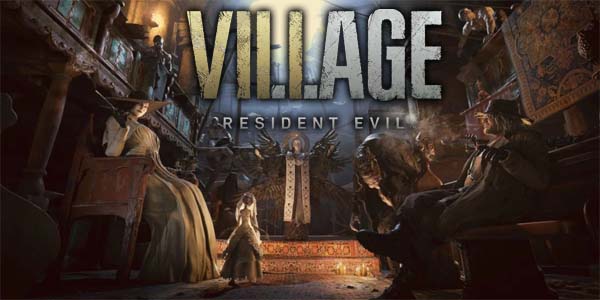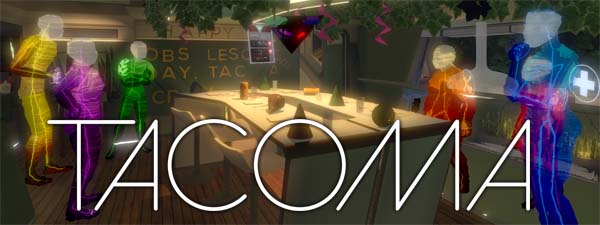
Village seems to be positioning itself as a sort of "greatest hits" of earlier Resident Evil games. I'm not sure it all comes together as well as Capcom must have hoped it would. Resident Evil VII Biohazard did an excellent job of modernizing the design philosophies of the original Resident Evil game. Map design, inventory and resource constraints, and the "fight or flight" nature of enemy encounters all perfectly re-captured the feel of the original PS1 classics, without all of the clunkiness.
Village maintains the exploratory map design of the original Resident Evil and of Resident Evil VII, but it also tries to port concepts and aesthetics from the Resident Evil 2 remake and from Resident Evil 4. The RE2 stuff fits well enough, but the RE4 influences just don't feel compatible with classic design philosophy.
The setting instantly reminded me of Resident Evil 4.
Clash of philosophies
Right off the bat, the general aesthetic screams "Resident Evil 4". The game begins in a small, rustic, eastern European village at the foot of a gothic castle. Just like in RE4, you're quickly ambushed by the monstrous villagers and have to desperately fight your way out. Resident Evil 4 replaced the traditional zombies of the series with semi-aware "ganados"; Village similarly breaks away from the traditional zombies, but this time, the monsters are werewolves.
Not long into the game, you'll start smashing crates to reveal hidden loot, and pixel-hunting along the walls and ceilings for obnoxious sparkling gems to shoot down and collect. Also just like in Resident Evil 4, you'll routinely get rewards of items and money from defeated enemies. That money and loot is used to buy items or upgrade your equipment at a shop, just like in Resident Evil 4. This is where the game started to break down for me.
Loot, ammo, and cash can be recovered from smashed crates or defeated enemies.
Giving the player rewards of in-game cash for defeating foes (and for wasting bullets to shoot glowing gems off of walls) completely changes the motivations of the player in how we deal with enemies. I'm no longer carefully considering whether to try to sneak past an enemy or run away, nor am I ever firing off a single round at an enemy's knee to stun or cripple it so I can get away without consuming more resources, the way I might in REmake2. Since every defeated foe returns some of the resources that I invest into killing it, there is no "fight or flight"; only "fight". The enemies stop being threatening or frightening, especially on the standard difficulty setting, in which ammunition is readily available and the monsters patiently await their turns to charge and attack.
Even inventory management is mostly thoughtless. The more linear, more action-oriented, and less puzzle-oriented design of the game means that key items and treasures are not put in your limited inventory, and there isn't even a storage box to keep excess weapons or supplies. Only weapons, ammo, and healing items go into your briefcase. Everything else has unlimited storage. Even crafting components have separate, unlimited storage (the only exception being the animals meats needed for the Duke to cook meals -- more on this later). [More]
b05b0e00-39c0-4ac3-9d47-9089537c0f54|1|5.0
Tags:Resident Evil, Resident Evil VIII Village, Capcom, horror, survival horror, action, shooter, Resident Evil 4, gothic horror, vampire, werewolf, Ethan Winters, Lady Dimitrescu, castle

I have one more game in my spring "walking sim" research. That game is the 2013 first-person horror game, Outlast, which (along with Amnesia: The Dark Descent) was instrumental in popularizing the "hide-and-seek" brand of horror gaming that became very popular in indie and low-budget horror games over the ensuing decade.
I liked Amnesia, and was interested in playing Outlast back around its release. I bought it years ago, and it ended up sitting in my unplayed Steam backlog until I installed it about a year ago, with the intent of playing it during the pandemic. But then I played other games, and Outlast sat around on my desktop this entire past year until I finally got around to playing it last month.
So was it worth the 8-year wait? Meh.
A haunted house permeated with uncertainty and surprise
At a very fundamental level, Outlast wanted to be a game that shocked and horrified players. In many regards, it's very successful at this endeavor, and it holds up pretty well in the 8 or so years since it released. The game starts off with a slow, ominous build that helps create an atmosphere of tension and uncertainty. But once the horrors start coming, it's a barrage of shockingly horrific violence and inhumanity. I was never quite sure what I was going to find on the other side of a door or at the end of a hallway.
Sadly, the over-the-top violence did turn out to be desensitizing. By less than halfway through the game, the mutilated bodies of inmates and guards just wasn't scary anymore. Thankfully, there's a few other shocks and surprises in store for the player that helped keep me from becoming too comfortable with what's going on around me.
I actually had plenty of spare batteries
at the end of the game.
Like with most good survival horror games, Outlast sets up an expectation of scarcity that makes players anxious about using supplies that are actually in fairly generous supply. Just like how Resident Evil provides more than enough Ink Ribbons to let you save whenever you come across a typewriter, and Silent Hill gives enough ammo and healing supplies to let players stand your ground against most enemies, Outlast provides plenty of batteries. I thought I was using the night vision fairly liberally throughout the game, yet still had 6 or 7 spare batteries on me at almost all times throughout the game, without ever feeling like I was going too far out of my way to search for them.
The only exception was going through the courtyard and female ward, which is basically just a resource sink. The courtyard itself is a pain in the ass to navigate, but it looks really cool. The blowing wind and lightning creates lots of visual and auditory tricks that kept me tense throughout the entire time. I thought I was seeing ghosts all over the place, but could never really be sure that it wasn't just a trick of the light. I came out the other side of the courtyard with like 2 or 3 spare batteries, which made me nervous whenever I saw a dark hallway or room in the ensuing level. But it didn't take long to get my battery reserves back up to a comfortable level.
The dark courtyard perhaps the most tense and frightening (and battery-consuming) level.
In fact, by the end of the game, the night vision seemed to become less critical to progress, as the final level or two of the game are very well lit. I got to a point where I wasn't able to pick up new batteries because my stock was already full. So perhaps Red Barrels could have been a bit more stingy with how many batteries it provides? Or maybe they could have made a few more levels of the game a bit more dark? As it stands, most areas in the game are either completely lit and do not require night vision at all, or they are pitch black and absolutely require batteries to see anything at all. This means that the game has to provide more than enough batteries; otherwise, progress becomes impossible. [More]

I spent a large chunk of my gaming time since last August playing football video games. With the season over, I wanted to spend a couple months playing other games before diving back into to football critique videos with the next installment of my "How Madden Fails To Simulate Football" series. I also recently played Outer Wilds, which gave me an idea for a new video essay about the evolution of walking simulators (video will be published soon, and I'll post it to the blog when it's released). So I spent pretty much all of March diving into my Steam backlog of walking simulators, replaying ones I'd played years ago, and spending some Patron funds to purchase ones I had never played.
One such game sitting in my Steam backlog for years was the divisive indie noir thriller Virginia. Players take on the role of a freshman FBI agent tasked with performing internal affairs oversight on her partner, who is currently investigating a case involving a missing teenager in a small Virginia town. The game shows its X-Files and Twin Peaks influences proudly on its sleeve, including a scene of lounge musicians performing a song that is a blatant homage to the title theme of Twin Peaks.
Virginia is heavily inspired by 90's thrillers X-Files and Twin Peaks.
What makes Virginia interesting as a game is its unique presentation. It uses very cinematic editing, with sudden cuts and montages during gameplay. I might start walking down a hallway on the first floor of the FBI building, then suddenly cut (mid-stride) to the hallway leading to my partner's basement office (just like the office of Agent Mulder in X-Files). This can be convenient because it spares the player from the unnecessary legwork of tediously walking through such a large building. This keeps the game focused on telling its story at a brisk, cinematic pace. When combined with the context of the situation, and the movie-quality soundtrack, this editing can build a lot of tension and suspense. Who would have thought that a montage of walking down empty hallways for less than a minute could be such a tense experience?
Furthermore, the levels are designed such that these edits sync up with player inputs so as to create a surprisingly smooth and purposeful stream of inputs. These aren't cutscenes. I remain in control of the character, and these sudden cuts rarely, if ever feel jarring. They might be surprising (especially the first few times they happen), but I never felt like I had no idea what was going on (with maybe a few exceptions late in the game).
Cinematic edits cut down on tedious travel and keeps the story moving at a brisk pace.
This style of carefully-paced editing can also be problematic. Scenes will sometimes transition without player input, creating frequent points of no return, even if I wanted to go back and examine something else or try another interaction. Even though the player remains in control throughout, I still had virtually no agency in how scenes would progress -- let alone how the larger story unfolds. This probably could have been a first-person animated film and wouldn't really lose much in the translation. [More]
c5dc5625-5ff9-4626-9764-5b9c39ae9131|0|.0
Tags:Virginia, Variable State, 505 Games, Pink Kong, noir, thriller, F.B.I., investigation, indie gaming, Steam, Good Old Games, PC, walking simulator, the X-Files, Twin Peaks

Here's another short sci-fi game from my Steam backlog. Tacoma is Fullbright's sci-fi follow up to its masterful walking sim Gone Home. This time around, instead of playing as a young girl discovering the secrets of your family, you play as an agent of a corporate conglomerate sent to retrieve the company's A.I. hard drive from a defunct space station in which an emergency threatened to kill the entire crew. Instead of reading notes and journal entries, you instead replay holographic representations of logs that the station's onboard A.I. recorded of conversations between the station's crew members.
You have to eavesdrop on recorded conversations as holograms move around the station.
The whole process is much more active and player-driven than the exposition of Gone Home (and other walking sims) because the holographic recordings of the characters move around the stations and converse in real time. You don't just walk into a room and read a conspicuously-placed note or listen to passive narration. You'll have to follow the characters between rooms, and keep track of multiple conversations at once as the characters come and go, and as they split up from large group meetings and start to have smaller, more private conversations. Each recording will usually have 2 or 3 independent conversation threads for you to follow. As you follow each character around, you'll also be spying on their personal text messages and emails.
This gives a greater sense of participation from the player (compared to many other walking sims) and provides a greater illusion that you are solving a mystery. That being said, there's nothing too challenging about finding and listening to all the possible conversations. They aren't elaborate puzzles that will take time to figure out. You just follow each character around the space and listen to them. It keeps the player interacting with the game space without ever applying a high bar for progress.
Don't expect to be stumped by the puzzles.
Without spoiling too much, there is only one ending, and you aren't going to be punished for not uncovering all the available evidence. The worst aspect of the game's "walkign sim" nature is that you're also never asked to apply any of the knowledge that you acquire from your investigations other than a handful of numeric combination codes for unlocking doors and the like. These codes are basically just progress gates to provide the illusion that the game has "puzzles", but the early exposure to these key codes will further encourage the player to snoop around more thoroughly for potential clues to future puzzles or progress gates. It isn't very intellectually challenging, but it does encourage the player to pay more attention.
[More]
ad0da423-9efe-41a3-b0fc-37ab8db4fe16|0|.0
Tags:Tacoma, Fullbright, science fiction, walking simulator, artificial intelligence, corporate culture, stock market, Amazon, Tyson Foods, COVID-19, pandemic
![Event [0] - title](/image.axd/2021/3/Event0-title-600x250.jpg)
Continuing on through my years-old backlog of indie Steam games, I moved away from Bloober Team games, but stuck with the sci-fi genre and played one of the most innovative games from 2016. I may be five years late to this one, but Event [0] is still a unique sci-fi mystery game that no other developers seem to have tried to emulate. As such, the game still holds up quite well.
The central premise here is that you find yourself in an abandoned space station in orbit around Jupiter. Your only companion is an onboard A.I. named Kaizen who talks to you through text on computer terminals scattered throughout the small station. The gimmick here is that all your interactions with Kaizen are handled by typing questions or commands into the computer terminals using your keyboard. The game uses some natural speech recognition algorithms to parse your text, interpret its meaning, and compose an appropriate response for Kaizen. It's like installing CleverBot into your game as an NPC.
The only other character is the possibly-malfunctioning onboard A.I., who you can type questions or commands to.
Even 5 years later, it's still a wholly unique way of interacting with an in-game NPC, and Kaizen comes off as being fairly believable. It certainly helps that the developers decided to make Kaizen an A.I. character instead of a human NPC, since it makes your interactions with Kaizen feel a bit more natural and believable. And when Kaizen gives a nonsensical response, it's easy to chalk it up to it being a malfunctioning A.I..
You are expected to explore the space station, investigating the environment for clues, and asking Kaizen questions to help you unravel the mystery of what happened to the crew of the station. The station only has a handful of rooms, and only had [I think] 3 crew members on it, so it doesn't take long to figure out what happened. In fact, the whole game is playable within about 2 or 3 hours, and repeat play throughs (to get alternate endings or whatever) can be completed in an hour or less. [More]
|

| 12 | | | | | | | 60 | | 11 | | | | | | | 55 | | 10 | | | | | | | 50 | | 09 | | | | | | | 45 | | 08 | | | | | | | 40 | | 07 | | | | | | | 35 | | 06 | | | | | | | 30 | | 05 | | | | | | | 25 | | 04 | | | | | | | 20 | | 03 | | | | | | | 15 | | 02 | | | | | | | 10 | | 01 | | | | | | | 05 |
|